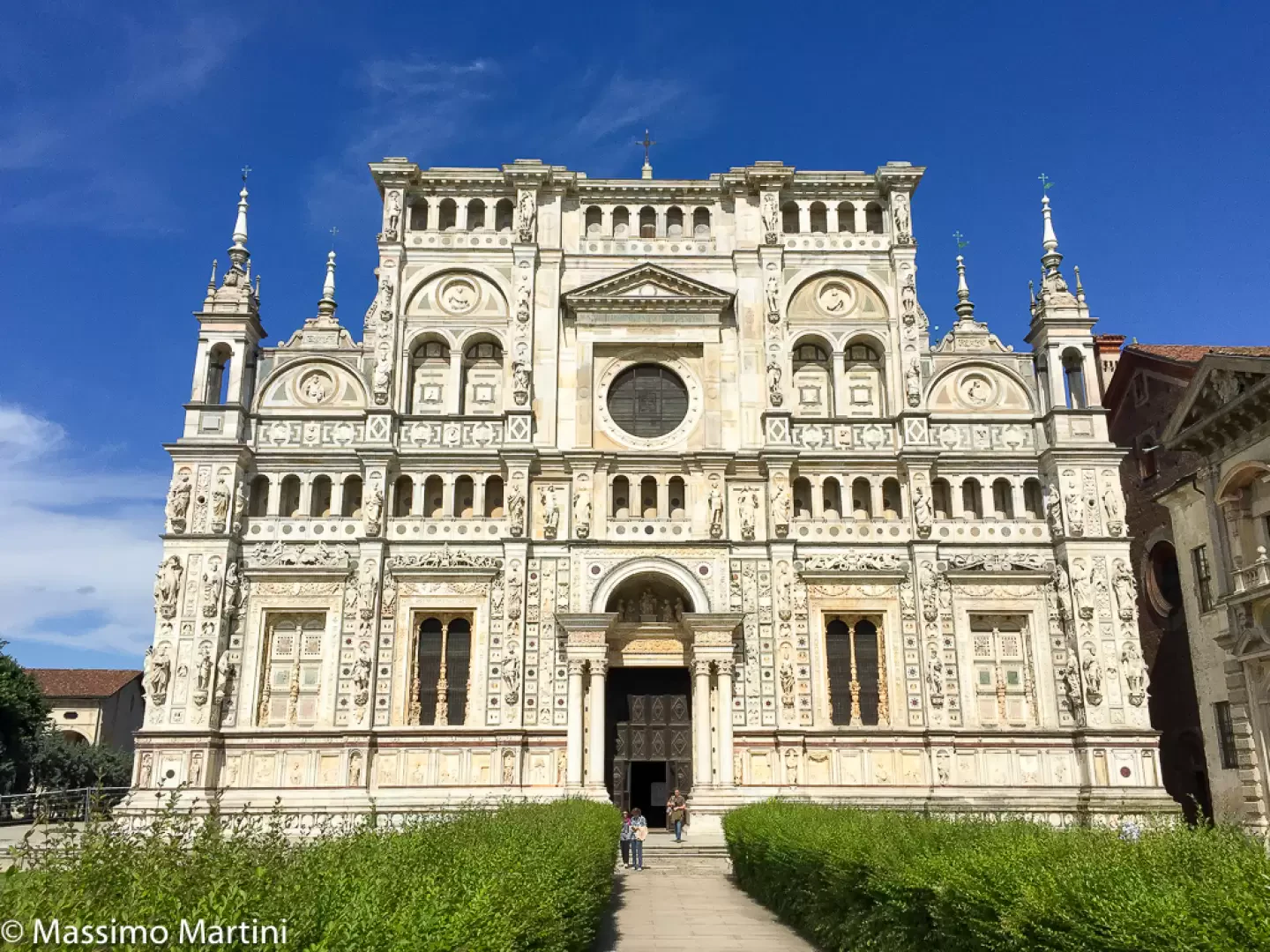Charterhouse of Pavia Gra-Car

Access
The Certosa di Pavia is easily accessible thanks to its strategic location in the heart of Lombardy, a short distance from both Milan and Pavia. The nearest airports are Milan Malpensa, Milan Linate and Bergamo Orio al Serio, which offer national and international connections. From these airports, it is possible to continue on to the Certosa using public transport or car rental services.
Train travellers can rely on the nearby Certosa di Pavia railway station, located a few kilometres from the monumental complex. This station is connected to the main Milan and Pavia railway lines, ensuring convenient and quick access. For those arriving from the Milan Central or Pavia stations, regional trains are available that make frequent stops at the local station. From the station, a short bus ride or walk takes you to the abbey.
Access by car is facilitated by its proximity to the motorway network. Coming from Milan, you can take the Milan-Genoa motorway, exiting at the Binasco tollgate and following the signs for Certosa. From Pavia, on the other hand, it is advisable to take the provincial road , also known as the 'Statale dei Giovi,' which offers a direct and smooth connection. The provincial road network is well developed and road signs are clear and frequent, easily guiding visitors to the monumental complex.
For those who prefer a more immersive access to nature, hiking and cycling routes are available through the surrounding countryside. One of the most attractive routes starts from the centre of Pavia, following the Parco Visconteo and skirting the Naviglio Pavese. This itinerary makes it possible to combine a relaxing walk with a visit to the Charterhouse, immersed in the tranquillity of the Lombardy countryside.
In any case, whatever means of transport you choose, reaching the Charterhouse of Pavia is simple and well-organised, making this extraordinary monumental complex accessible to all those who wish to discover one of the most fascinating places in Lombardy.
Introduction
The Charterhouse of Pavia, located in the heart of Lombardy a few kilometres from the city of Pavia, is one of the most important monumental complexes of the Italian Renaissance. Founded in 1396 at the behest of Gian Galeazzo Visconti, Duke of Milan, the Charterhouse was created as a family mausoleum and symbol of the greatness of the Milanese dukedom. Surrounded by nature and set at the edge of the Parco Visconteo, the abbey offers a unique experience that interweaves art, spirituality and scenic beauty.
Description
His history is a fascinating journey through the centuries. The construction, begun under the guidance of Bernardo da Venezia and continued by masters such as Giovanni Solari and his son Guiniforte, was a monumental undertaking that went on for over two hundred years. The passage of power from the Visconti to the Sforza and the political vicissitudes of the time influenced the project, enriching it with the contribution of extraordinarily talented artists such as Giovanni Antonio Amadeo and the Mantegazza brothers. Over time, the Carthusian Monastery not only changed its use from a ducal mausoleum to a Carthusian monastic centre, but also suffered episodes of abandonment and pillage, such as during the Napoleonic era, only to be returned to the Cistercian monks in 1968.
The architecture of the Carthusian Monastery is a masterpiece that harmoniously blends Gothic, Renaissance and Baroque elements. The church façade, a triumph of sculpted marble and polychrome decoration, is one of the most spectacular in Italy. The portal by Benedetto Briosco, the statues and reliefs depicting biblical scenes and mythological figures are evidence of the artistic fervour that animated Renaissance Lombardy. Inside, the three-nave church with a Latin cross plan is decorated with frescoes by Ambrogio da Fossano, known as il Bergognone, and embellished with Venetian-style flooring and a marble and semiprecious stone high altar.
The complex is built around two extraordinarily beautiful cloisters. The small cloister, with stone columns and architraves decorated in terracotta, leads to the refectory and community living areas. The large cloister, on the other hand, is a majestic work: with its 123 arches supported by marble columns and its decorative bas-reliefs, it is a perfect example of Renaissance balance and proportions. It is overlooked by the monks' cells, autonomous units with spaces for work, prayer and rest.
In addition to the church and cloisters, the Ducal Palace, designed in the 17th century by Francesco Maria Richini, is worth a visit. The palace, which now houses the Carthusian Monastery Museum, has a gipsoteca with casts of the original decorations and a collection of works of art from the Lombard Renaissance. The history of the palace, with its monumental staircase and loggia, is intertwined with that of the abbey, revealing the refinement of Visconti and Sforza patronage.
The Charterhouse is still a place of prayer and spirituality, inhabited by Cistercian monks. These religious monks, following a centuries-old tradition, devote themselves to the cultivation of the surrounding fields and the production of medicinal herbs, welcoming visitors with discretion and offering guided tours to discover the hidden treasures of the complex.
Visiting the Charterhouse of Pavia is a journey through time and spirit. Every corner tells a story, every work of art invites contemplation. It is a place that leaves a deep mark on the visitor's soul, a symbol of the human capacity to create eternal beauty.